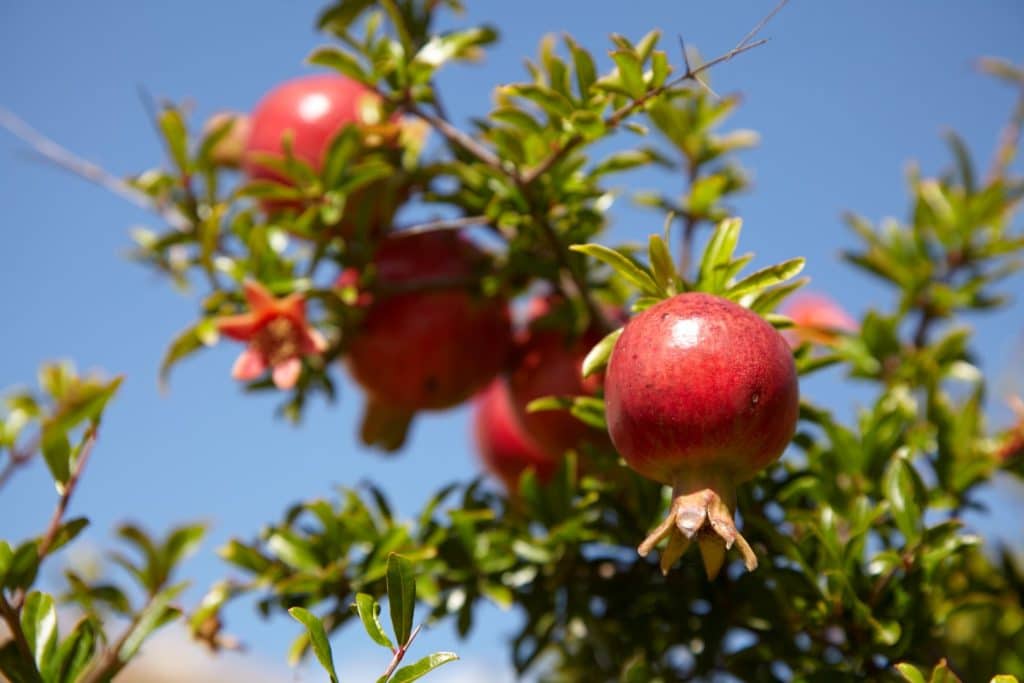Cyprus, with its warm Mediterranean climate and fertile soil, is home to a variety of native trees that have thrived for centuries. From the vibrant Oleander to the stately Olive, the trees of Cyprus are not only a crucial part of the island’s ecosystem but also hold significant cultural value. Here, we explore the 20 most common trees you’ll encounter in Cyprus, each adding to the rich biodiversity and natural beauty of the region.
1. Royal Poinciana (Delonix regia)

Also known as the “peacock tree” or “flamboyant tree,” the Royal Poinciana is a fast-growing tree native to Madagascar. Its bright crimson or red-yellow flowers make it one of the most visually stunning trees in Cyprus.
Plant Height: 8 m to 12 m
2. Chinaberry Tree (Melia azedarach)
The Chinaberry Tree is another invasive species, known for forming dense thickets that can crowd out native plants. Despite its attractive appearance, this tree is toxic to humans and many animals, though certain birds and cattle can eat the fruit without harm.
Plant Height: 7 m to 12 m
3. Olive (Olea europaea)
The Olive Tree is synonymous with the Mediterranean and holds a place of great agricultural and symbolic importance in Cyprus. This evergreen tree is cultivated for its fruit, which is used to produce olive oil, a staple in Cypriot cuisine. The olive branch has long been a symbol of peace and glory.
Plant Height: 4 m to 15 m
4. Octopus Tree (Schefflera actinophylla)
The Octopus Tree, also known as the Australian Umbrella Tree, is noted for its unusual, drooping leaves that resemble an octopus’ tentacles. Native to Queensland, Australia, this tree can become invasive if not carefully managed.
Plant Height: 6 m to 20 m
5. Pomelo (Citrus grandis)
The Pomelo is the largest citrus fruit in the world, often considered the ancestor of the grapefruit. Though it has a thick, difficult-to-peel rind, the fruit is a popular treat in Southeast Asia and is gaining popularity in Cyprus.
Plant Height: 5 m to 15 m
6. Blue Jacaranda (Jacaranda mimosifolia)
The Blue Jacaranda is a species native to South America but widely grown in many cities, including those in Cyprus. Known for its beautiful blue-purple flowers, this tree is often celebrated in literature and song.
Plant Height: 5 m to 20 m
7. Red Frangipani (Plumeria rubra)
The Red Frangipani is a deciduous shrub or small tree that hails from Central and South America but has made itself at home in the warm climates of Cyprus. It’s admired for its stunning flowers, but all parts of this plant are toxic due to their high alkaloid content. This tree adds a tropical flair to the Cypriot landscape.
Plant Height: 2 m to 8 m
8. Weeping Fig (Ficus benjamina)
The Weeping Fig is a versatile evergreen tree that is particularly popular as a houseplant. Its graceful, glossy leaves make it a favourite in homes and offices. However, those with allergies should take care, as this plant is a significant source of indoor allergens.
Plant Height: 7 m to 30 m
9. Yellow Trumpetbush (Tecoma stans)
Despite its bright, attractive flowers, the Yellow Trumpetbush is considered an invasive species in many parts of the world. In Cyprus, it is often found in disturbed sites and along roadsides, where it can thrive in less-than-ideal conditions.
Plant Height: 6 m to 9 m
10. Mastic Tree (Pistacia lentiscus)
The Mastic Tree is an evergreen that thrives in the coastal regions of Cyprus, where it’s valued for its aromatic resin, known as mastic. This tree’s small red fruits ripen to black in the autumn, and its strong resinous scent is unmistakable.
Plant Height: 1 m to 5 m
11. Common Fig (Ficus carica)
The Common Fig is a deciduous small tree or shrub that has been cultivated since ancient times. Known for its sweet, chewy fruits, the fig tree has a storied history that dates back to the tenth millennium BC. In Cyprus, figs are a beloved fruit, enjoyed fresh or dried.
Plant Height: 3 m to 10 m
12. Rubber Tree (Ficus elastica)
The Rubber Tree, with its broad, glossy leaves, is a familiar sight in both gardens and homes as an ornamental plant. Although its milky latex was once used to produce rubber, it has since been replaced by the Pará rubber tree. This species, however, remains popular for its striking appearance.
Plant Height: 20 m to 40 m
13. Lemon (Citrus limon)
The Lemon Tree is a small evergreen tree cultivated for its sour, juicy fruits, which are rich in citric acid. While the exact origins of the lemon are uncertain, it is believed to have been first cultivated in India, China, or Burma. In Cyprus, lemons are a key ingredient in many traditional dishes.
Plant Height: 2 m to 6 m
14. Corn Plant (Dracaena fragrans)
Native to tropical Africa, the Corn Plant is a slow-growing perennial shrub that has been cultivated in Europe since the 1800s. Its tall, cane-like structure topped with lush, glossy leaves makes it a popular choice for indoor decoration.
Plant Height: 4.5 m to 15 m
15. Norfolk Island Pine (Araucaria heterophylla)
Though native to Norfolk Island in the Pacific, the Norfolk Island Pine is a popular houseplant worldwide. This conifer is under threat in its natural habitat, but it continues to be cherished for its symmetrical, evergreen form.
Plant Height: 50 m to 65 m
16. Indian Laurel (Ficus microcarpa)
Native to China, the Indian Laurel is a large fig tree that is not only an attractive addition to Cypriot gardens but also plays an important ecological role. This tree has a special relationship with the fig wasp, which pollinates its flowers. In some East Asian cultures, the Indian Laurel is believed to be a gathering place for spirits.
Plant Height: 15 m to 25 m
17. Carob Tree (Ceratonia siliqua)
The Carob Tree is a hardy evergreen shrub native to the Mediterranean region, including Cyprus. It’s widely cultivated for its edible pods, which are often ground into a powder used as a chocolate substitute. Carob trees are also a common feature in ornamental gardens and landscaping.
Plant Height: Up to 15 m
18. Oleander (Nerium oleander)
Oleander is a striking shrub or small tree, easily recognisable by its vibrant pink, five-lobed flowers and deep green lance-shaped leaves. Though it’s a popular choice for ornamental gardens across Cyprus, it’s important to note that Oleander is highly toxic. Care should be taken to keep children and pets away from this beautiful yet dangerous plant.
Plant Height: 2 m to 6 m
19. Pomegranate (Punica granatum)

Punica granatum
Pomegranate Trees have been cultivated for thousands of years, and their fruits are highly valued in both culinary and symbolic contexts. In Cyprus, pomegranates are a common sight in gardens, where they add both beauty and bounty.
Plant Height: 1.8 m to 6 m
20. Orange Wattle (Acacia saligna)
Originally from Australia, the Orange Wattle has found a second home in Cyprus, where it’s often planted in semi-arid regions to combat soil erosion. This small tree produces bright yellow flowers in late winter and early spring, adding a splash of colour to the landscape.
Plant Height: 6 m to 9 m
Where to Find These Remarkable Trees
For visitors eager to experience the natural beauty of Cyprus, many of these trees can be found in some of the island’s most picturesque locations. The Troodos Mountains, with their lush forests, are home to ancient olive groves and majestic pines, while the Akamas Peninsula offers a chance to see endemic species like the Cyprus Cedar in their natural habitat. Urban parks such as the Athalassa National Forest Park in Nicosia or the Limassol Municipal Gardens also provide accessible locations for tourists to admire these trees up close.
Trees and Their Cultural Significance
Many of the trees featured in this list are not just beautiful to look at; they also hold deep cultural and historical significance in Cyprus. The Olive Tree, for example, is central to Cypriot heritage, symbolizing peace and prosperity. Visitors can explore ancient olive groves, some of which date back thousands of years, and learn about the traditional olive oil production methods still used today. Meanwhile, the Carob Tree, once referred to as “black gold,” played a vital role in the island’s economy and is still celebrated in local festivals.
Engaging with Cyprus’ Flora
To truly connect with the island’s unique flora, tourists can take part in various activities that highlight these remarkable trees. Guided nature walks and botanical tours are available across the island, offering an educational and immersive experience. Visitors can also embark on hiking trails that meander through forests and hillsides, providing an up-close view of species like the Aleppo Pine and the Strawberry Tree. These activities not only showcase the trees but also provide a deeper appreciation of Cyprus’ rich biodiversity.
Capture the Beauty of Cyprus’ Trees
For photography enthusiasts, the trees of Cyprus offer a perfect subject to capture the island’s natural beauty. Whether it’s the vibrant blossoms of the Royal Poinciana in full bloom or the ancient, twisted trunks of olive trees, these species provide stunning backdrops for memorable holiday photos. Consider using this article as a checklist, challenging yourself to find and photograph each of these 20 remarkable trees during your visit. It’s a unique way to document your travels and bring a piece of Cyprus’ natural heritage home with you.
Conclusion: The Living Heritage of Cyprus’ Trees
The trees of Cyprus are more than just plants; they are living monuments that tell the story of the island’s natural and cultural heritage. From ancient olive groves that have witnessed centuries of history to the vibrant blossoms of frangipani that adorn gardens and parks, these trees are an integral part of life in Cyprus. Their presence not only enhances the island’s biodiversity but also offers shade, sustenance, and inspiration to those who live among them. As you explore Cyprus, take a moment to appreciate these silent guardians of the landscape, each with its own story to tell and its own role to play in the ecosystem.
Frequently asked questions
What is the most common tree in Cyprus?
The most prevalent tree across Cyprus is the Calabrian pine (Pinus brutia). These forests dominate much of the island’s landscape, covering roughly 18.2% of the land. These pines thrive from sea level up to the mountainous regions, reaching elevations of about 1,200 to 1,400 meters.
What is the famous tree in Cyprus?
The Golden Oak (Quercus alnifolia) holds a special place in Cyprus as its national tree. This endemic species, known for its unique golden-hued leaf undersides, symbolizes the island’s natural heritage. The genus name Quercus is the ancient Latin word for oak, and “alnifolia” refers to the resemblance of its leaves to those of the alder tree.
What trees are endemic to Cyprus?
Among the island’s flora, the Cyprus cedar (Cedrus brevifolia) and the Golden Oak are notable as the only endemic tree species. The Golden Oak can appear as either a small tree or a high shrub, depending on its environment, while the Cyprus cedar is more exclusively a tree.
What is Cyprus’ national tree?
Cyprus’ national tree is the Golden Oak, an evergreen known for its distinctive golden undersides on the leaves. This tree was officially designated as the national tree by the Cypriot Parliament in February 2006, representing the unique natural beauty of the island.






